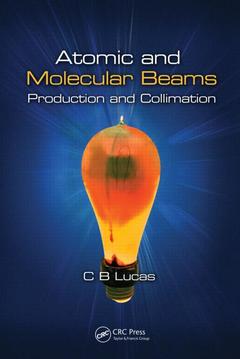Description
Atomic and Molecular Beams
Production and Collimation
Author: Lucas Cyril Bernard
Language: English
Subjects for Atomic and Molecular Beams:
Keywords
Atomic Beam; Capillary Array; capillary; Beam Formation; arrays; Axial Intensity; axial; Radiation Shields; intensity; Graphite Oven; free; Beam; path; Supersonic Beam; cosine; Interatomic Collisions; distribution; Angular Distribution; angular; Caesium Beam; caesium; Boron Nitride; Pyrolytic Boron Nitride; Magnetic Elds; Fractional Open Area; Free Path; High Pressure Equations; Cosine Distribution; Oxygen Free High Conductivity Copper; MONTE CARLO; Beam Halfwidth; Tungsten Tube; Clausing Function; Transmission Probability; Single Capillary
262.97 €
In Print (Delivery period: 15 days).
Add to cartPublication date: 12-2013
Support: Print on demand
Publication date: 10-2017
· 15.6x23.4 cm · Paperback
Description
/li>Contents
/li>Readership
/li>Biography
/li>
Atomic and molecular beams are employed in physics and chemistry experiments and, to a lesser extent, in the biological sciences. These beams enable atoms to be studied under collision-free conditions and allow the study of their interaction with other atoms, charged particles, radiation, and surfaces. Atomic and Molecular Beams: Production and Collimation explores the latest techniques for producing a beam from any substance as well as from the dissociation of hydrogen, oxygen, nitrogen, and the halogens.
The book not only provides the basic expressions essential to beam design but also offers in-depth coverage of:
- Design of ovens and furnaces for atomic beam production
- Creation of atomic beams that require higher evaporation temperatures
- Theory of beam formation including the Clausing equation and the transmission probability
- Construction of collimating arrays in metals, plastics, glass, and other materials
- Optimization of the design of atomic beam collimators
While many review articles and books discuss the application of atomic beams, few give technical details of their production. Focusing on practical application in the laboratory, the author critically reviews over 800 references to compare the atomic and molecular beam formation theories with actual experiments. Atomic and Molecular Beams: Production and Collimation is a comprehensive source of material for experimentalists facing the design of any atomic or molecular beam and theoreticians wishing to extend the theory.
Introduction. The Kinetic Theory of Gases and Atomic Beam Terminology. The Design of Ovens. Ovens for Evaporation of Alkali Metals and Their Salts. Ovens for Higher Temperatures. The Production of Beams of Dissociated Atoms and Other Radicals. Gases. The Theory of Collimated Atomic Beam Formation. Designing an Atomic Beam. Techniques of Multichannel Collimator Construction. The Comparison of Theory with Measurements. Other Indications. Concluding Observations.
C.B. Lucas studied physics and obtained his Ph.D at University College London. He held successive research posts at the UKAEA Culham Laboratory, the universities of Tübingen, York, Münster, and Royal Holloway College of the University of London. The remainder of Lucas’ full-time career was in administrative posts, but in his retirement he has kept in contact with the academic world as a part-time tutor for the Open University and particularly in continuing with the research needed to produce this book.




